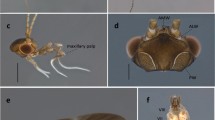Abstract
A 3 year field study ofScymnodes lividigaster (Mulsant) adults near Sydney indicated sex ratios close to 50∶50, ♀∶♂. Ratios deviated between samples collected in various periods of year and in individual years. Deviation was related to collecting methods, environmental conditions and behaviour of sexes in different developmental phases. SamplingLeptothea galbula (Mulsant) in 2 different habitats indicated all sex ratios biased towards ♀; ratios apparently not related to collecting methods and with little seasonality. In laboratory sex ratios ofL. galbula were close to 50∶50.
Résumé
Trois années d'étude deScymnodes lividigaster (Mulsant) dans les conditions naturelles près de Sydney ont montré que la proportion des sexes était 50∶50. Les proportions varient selon les échantillons prélevés à différentes périodes de l'année et suivant les années. Les variations dépendent des méthodes de prélèvement, des conditions de milieu et du comportement des sexes aux différentes étapes de leur développement. L'échantillonnage deLeptothea galbula (Mulsant) dans 2 habitats différents a mis en évidence des proportions des sexes favorables aux femelles, sans relation apparente avec les méthodes de collecte et avec peu de dépendance avec la saison. Au laboratoire la proportion de sexes deL. galbula était voisine de 50∶50.
Similar content being viewed by others
References
Anderson, J. M. E. — 1979a. Seasonal cycles of development in two species of Australian ladybirds [Coleoptera: Coccinellidae], with special reference to their reproductive diapause. —Ph. D. Thesis, Univ. New South Wales.
Anderson, J. M. E. — 1979 b. Biology and distribution ofScymnodes lividigaster (Mulsant) andLeptothea galbula (Mulsant)[Coleoptera: Coccinellidae]. — Proc. Linn. Soc. N.S.W., 26.
Anderson, J. M. E. &Richards, Aola. M. — 1977. First record of reproductive diapause and aggregation in AustralianCoccinellidae [Colepotera]. —Proc. Linn. Soc. N.S.W., 102, 13–17.
Blackman, R. L. — 1965. Specificity in predator-prey relationships, with particular reference to the aphidophagousCoccinellidae. — Ph. D. Thesis. Univ. London.
Chapman, R. F. — 1969. The Insects: Structure and Function. —English Univ. Press, Lond., 819 pp.
Dyer, J. G. &Swift, F. C. — 1979. Sex ratio in field populations of phytoseiid mites [Acarina: Phytoseiidae]. —Ann. Entomol. Soc. Am., 72, 149–154.
Engelmann, F. — 1970. The Physiology of Insect Reproduction. —Pergamon Press, Oxford, 307 pp.
Greenslade, P. J. M. — 1964. The distribution, dispersal and size of a population ofNebria brevicollis (F.) with comparative studies on three otherCarabidae. —J. Anim. Ecol., 33, 311–333.
Hagen, K. S. — 1962. Biology and ecology of predaceousCoccinellidae. —Annu. Rev. Entomol., 7, 289–326.
Hales, D. F. (collator). — 1978. Aspects of the biology ofHarmonia conformis Boisd. [Coleoptera Coccinellidae]. —Circ. Entomol. Soc. Aust. (N.S.W.), 288, 37.
Hodek, I. — 1967. Bionomics and ecology of the predaceousCoccinellidae. —Annu. Rev. Entomol., 12, 79–104.
Honek, A. — 1975. Colour polymorphism inAdalia bipunctata in Bohemia [Coleoptera: Coccinellidae]. —Entomol. Ger., 1, 293–299.
Imms, A. D. — 1960. A General Textbook of Entomology. —Methuen & Co. Ltd., Lond., 886 pp.
Matsuka, M., Hashi, H. &Okada, I. — 1975. Abnormal sex-ratio found in the lady beetleHarmonia axyridis Pallas [Coleoptera: Coccinellidae]. —Appl. Entomol., Zool., 10, 84–89.
McMullen, R. D. — 1967. A field study of diapause inCoccinella novemnotata [Coleoptera: Coccinellidae]. —Can. Entomol., 99: 42–49.
Smith, B. C. — 1966. Significance of variation in the weight, size and sex ratio of coccinellid adults. In: Ecology of Aphidophagous Insects (I. Hodek, ed.). —Junk, The Hague, 360 pp.
Southwood, T. R. E. — 1966. Ecological Methods with Particular Reference to the Study of Insect Populations. —Methuen & Co. Ltd., Lond., 391 pp.
Stevens, L. M., McGuire, J. U., Steinhauer, A. L. &Zungoli, P. A. — 1977. The observed sex ratio ofPediobius foveolatus [Hym.: Eulophidae] in field populations ofEpilachna varivestis [Col.: Coccinellidae]. —Entomophaga, 22, 175–177.
Suomalainen, E., Saura, A. &Lokki, J. — 1976. Evolution of parthenogenetic insects. —Evol. Biol., 9, 209–257.
Author information
Authors and Affiliations
Rights and permissions
About this article
Cite this article
Anderson, J.M.E. Sex ratios of adultScymnodes lividigaster andLeptothea galbula [Col.: Coccinellidae], sampled in the field. Entomophaga 26, 39–45 (1981). https://doi.org/10.1007/BF02371832
Issue Date:
DOI: https://doi.org/10.1007/BF02371832




